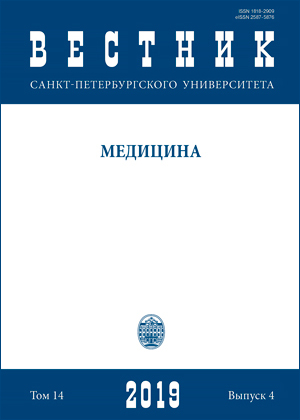EDITORIAL
Аннотация
The 4th Academy of Autoimmunity 11–13 October 2019 in Saint Petersburg State University was the biggest among all the previous ones and attended by hundreds of participants from 10 countries and from many cities of Russia. It brought all the novelties in autoimmunity in the last 2 years [1]. The development of autoimmune diseases is multifactorial and subordinated to laws of the additive polygenetic inheritance with the threshold effect from the side of a whole series of natural and sociocultural anthropogenic epigenetic factors, sometimes even including iatrogenic ones [2].Since the autoimmune diseases of different organs and systems have much in common considering their pathophysiology, clinical manifestations, as well as their prevention and treatment approaches, a new interdisciplinary branch of Medicine — Autoimmunology
— has formed recently in front of our eyes [3]. About 90 autoimmune diseases have been described, which implicate all organs and systems. Autoimmunity related morbidity and mortality steadily grow in all developed countries. There are strong evidences for existence of autoimmune/autoinflammatory links in pathogenesis of severe COVID-19 cases of current global pandemic [4]. In spite of the successes in the study of aetiology, pathogenesis and models of many autoimmune illnesses, the nature of the general disturbances, which underlie various particular forms of autoimmune disorders, remains the urgent object of scientific discussions. At the same time practical health care worldwide experiences the utmost need for their target prophylaxis and effective modalities of the treatment, whose adverse effects would be minimized. The evolution of nature and development of civilization set many new challenges for biomedical science and for health care system, and there is great possibility that the 21st century will turn into an Aeon of Autoimmunity. This trend may in future change the whole philosophy of Clinical Medicine. The current believe how autoimmune diseases are induced entails the combination of Genetics and environmental factors. Basically the genotype determines individuals who may have inherited characteristics making them to have a hyperactive immune system (i.e. HLA DRb1). The environmental factors include first of all those compounds that have an adjuvant effects (from the Latin word: adjuvare — “to help or aid”). It means that such a factor may enhance immune responses modifying the immune interactions [5]. In the presence of primary individual hereditary predisposition the pathological autoimmunity can manifest itself differently under the influence of various exogenous adjuvants or, vice versa — immunosuppressive factors — interplaying at different life periods of a concrete person, while autoimmune disorders in her/his body seem to flow from one nosological entity to another, keeping similar background which principle is known as the “kaleidoscope of autoimmunity” [6]. That is the main subject of recent important scientific and educational event: 4th Academy of Autoimmunity at Saint Petersburg State University [1]. The lessons, given by this Academy include update on the ASIA syndrome (autoimmune syndrome induced by adjuvants) and better understanding how these adjuvants may affect B- and T-lymphocytes. Moreover, updates on diseases like diabetes mellitus type I, systemis lupus erythematosus, myopathies, spondyloarthritis, systemic sclerosis and autoimmune thyroid diseases were delivered by world experts in the fields. In poster sessions we observed the descriptions of rare unusual cases of autoimmune diseases and new methods of their diagnosis. Yet new autoimmune entities and suspected autoimmune facets of various diseases were discussed like HPV vaccines autoimmunity, cancer in autoimmune diseases, arrhythmogenic autoantibodies that may cause death (“lethal autoantibodies”). Novel interrelations like those between endometriosis and autoimmunity were raised and how the life style can positively affect the autoimmune tendency including a new body manipulation of the myofacial syndrome. The Academy discussed how to handle the new aspects of health into the hospital and dealing with BIG DATA in order to better understand autoimmune phenomena. The impact of autoimmunity into several actual problems of current Medicine, like infertility, antiphospholipid syndrome, enigma of sarcoidosis or the adverse effects of checkpoint inhibitor treatment in oncological patients and phenomenon of polyneuropathy involving small neural fibers — all these matters were in scope of attention during 4th Academy of Autoimmunity. The experts in immunodiagnostics, clinical and experimental Pathophysiology brought to this Academy new ideas and data concerning the application of new clinical and experimental techniques, like multiplex autoantibody screening, advanced ultrasound visualization of lymphoid organs or transgenic animal models — for the purposes of applied and fundamental Autoimmunology. The pathways of interaction between the immune, nervous and endocrine systems, integrating human organism, were also among the topics discussed. Autoimmunology stands “on the shoulders of the giants” — the outstanding scholars of the past, like Paul Ehrlich (1854–1915) and Ilya I. Mechnikov (1845–1916). We see a special sign that this event took place within the walls of the St. Petersburg University, where Ilya I. Mechnikov worked, in the year of the 150th anniversary of the birth of his pupil, another pioneer of Immunology — Efim S. London (1869–1939), who also worked at this university and was the first who demonstrated the presence of autoantibodies in healthy individuals and existence of antiantibodes, much lated re-discovered and named antiidiotypes [7; 8]. Many young researchers and medical doctors, as well as students took part in 4th Academy to continue this great tradition of autoimmunity studies which rooted here long ago.We wish them success and hope to see all of the participants also in the 12th Congress on Autoimmunity in Athens, Greece, 28 May — 1 June 2021 [9].
Скачивания
Библиографические ссылки
References
Загрузки
Опубликован
Как цитировать
Выпуск
Раздел
Лицензия
Статьи журнала «Вестник Санкт-Петербургского университета. Медицина» находятся в открытом доступе и распространяются в соответствии с условиями Лицензионного Договора с Санкт-Петербургским государственным университетом, который бесплатно предоставляет авторам неограниченное распространение и самостоятельное архивирование.




